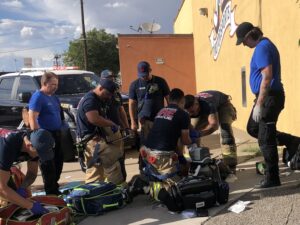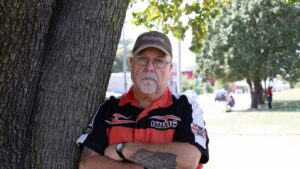8:00
News Story
To tackle slowdown in vaccine demand, providers work to break down barriers to access
Barriers include providing more options for people with a lack of transportation and info in more languages
When KC Care Health Center ramped up its COVID-19 vaccine rollout earlier this year, staff couldn’t keep up with demand. Doses went into patients’ arms as soon as they came in.
So when Missouri made all adult residents eligible for the vaccine a week-and-half ago, Adria Edwards, director of special projects for the federally qualified health center, assumed demand would skyrocket.
Instead, Edwards said demand has fallen by half or more — despite the fact that only one-third of Missourians have gotten at least one shot.
“I think that the people who were very interested in getting the vaccine found a way to get it before now,” Edwards said, “and so now I think we’re at the point where it’s going to be the individuals who are maybe less comfortable or more distrustful of our healthcare system.”
Vaccine clinics across the state have faced a similar predicament. Last week alone, thousands of appointments were available across St. Louis County to Columbia, with health departments working to spread the word.
“We knew the switch was going to be flipped. I thought it might be more of a dimmer switch,” said Christopher Ave, a spokesman for the St. Louis County Department of Public Health. “But as it turns out, it wasn’t a dimmer switch.”
State officials have forecast for weeks that vaccine supply would soon outpace demand, and last week was the first time that order requests from providers dipped, said Lisa Cox, a spokeswoman for the state health department.
And while an April poll commissioned by the Missouri Hospital Association found nearly 30 percent of respondents said they didn’t plan to seek a vaccine, hesitancy is far from the only factor affecting demand.
Vaccination rates are still lagging among certain demographic groups, like Black Missourians, and slowing among others like those 65 and older, despite Missouri’s attempts to prioritize the vulnerable.
Barriers to access still need to be broken down — like providing more options for people with demanding work schedules or a lack of transportation and info in language options for non-native English speakers.
It wasn’t until Tuesday that the state launched a Spanish-language version of its vaccine registration system, Vaccine Navigator, with additional languages on the way.
More than 75,000 are registered with the system, and of new registrants, 33,000 identified as being homebound or needing transportation assistance, Cox said Tuesday on a call with vaccine providers. The state has compiled a list of resources to assist with getting a ride.
It’s those gaps that providers are now focusing their efforts on, moving from an approach of larger vaccination events to adding more tailored clinics to meet the needs of specific groups. At a federal level, President Joe Biden called for employers to give workers paid time off to get vaccinated or recover from the shot.
Riisa Rawlins-Easley, chief of staff for the St. Louis Regional Health Commission, said it’s an opportunity to see where the medical system has historically not reached communities and engage those groups.
The St. Louis Regional Health Commission has put a focus on building bridges between patients, providers and community — and has advisory boards tailored to each. It’s a similar spirit of collaboration they’re carrying forward with education campaigns around the vaccine and a new webpage that puts resources in one place to connect organizers with providers who can help host a community vaccination event.
“I think what we lack is a real centralized, coordinated approach to ensuring that the supply is matched well with folks who are interested,” Rawlins-Easley said, later adding: “And so now, what I’m excited about is that we are — late, but better late than never — trying to coordinate all of the moving pieces so that supply gets to demand to try to close some of those loops.”
Hesitancy and access

For Bilingual International Assistant Services, which works with primarily elderly, immigrant communities in St. Louis, hesitancy and barriers to access exist simultaneously.
“Both scenarios are equally true,” said Jason Baker, the organization’s executive director. “We are seeing clients who want to get the vaccine, who are running up against structural barriers, the main one being language access. Another one being transportation.”
At the same time, Baker said hesitancy can be difficult to chip away at, like distrust in government solutions to large scale problems given some groups’ history in their home countries.
In February, Lori Stoll, health promotion coordinator for Catholic Charities of Central and Northern Missouri, the only refugee resettlement agency in Columbia, embarked on calling over 100 refugees to survey not only their interest in receiving a vaccine, but what hurdles existed.
“From that survey, we gained that there was some hesitancy, but moreover, there was a lack of any information being targeted to their populations,” Stoll said.
With the pandemic upending traditional points of congregation, like senior centers or English classes, getting information out requires more time-intensive, one-on-one phone calls. Bilingual International is used to helping clients navigate complicated systems, like Medicaid, but with the vaccine rollout, new information comes out daily.
Through Catholic Charities of Central and Northern Missouri’s survey, the agency has been able to pinpoint avenues to disseminate info, like fliers translated into six languages, helping clients get to appointments and holding an information session with the Columbia/Boone County Department of Public Health and Human Services on Wednesday.
“It’s important to all of us, for everyone, regardless of culture, to have access to the vaccine and access to health information,” Stoll said. “And to treat each person with dignity and give them information in a level that they could understand.”
The ultimate goal: to host a vaccination clinic at the agency’s office in the next few weeks.
Expanding options

Much of the vaccine rollout’s model has been based on getting people to the vaccine, rather than bringing it to them. Cox said that’s, in part, because of the large quantities the vaccine comes in — a tray of 1,170 doses for Pfizer, 100 for Moderna at minimum — make it more difficult to supply providers with smaller numbers.
Cox said smaller shipment sizes would help the vaccine get to more providers who might be more convenient for residents. While mass vaccination events work for many, it can’t be the only route, providers said, stressing that smaller events at trusted community centers are also needed. Improved accessibility is what vaccine providers are aiming to achieve by expanding the settings where they offer it.
“It’s in your doctor’s office, it’s all over the place, rather than requiring people to go to events at certain times,” Cox said.
Edwards said the KC Care Health Center has had to take a more proactive approach.
“Now that we have the supply, it has to be way more than just having a link up on our website,” Edwards said.
In Jackson County, the health department is adapting by offering clinics later in the evening and changing locations, said Mariah Cox, a spokeswoman for the department. It’s also partnering to vaccinate individuals in detention facilities in addition to the uninsured and people experiencing homelessness through Care Beyond the Boulevard’s mobile medical clinics.
In St. Louis County, the health department has eliminated pre-registration, and on Monday announced walk-up clinics. In addition to planning more events in collaboration with community providers and targeting specific groups, like those hard of hearing, it’s also vaccinated over 200 homebound residents and their caregivers through a partnership with fire districts and EMS, and has brought vaccine to senior living facilities that weren’t reached by the federal partnership with retail pharmacies.
“Just because you open a site, it doesn’t mean you’re going to get vaccine to the most vulnerable,” Ave said. “And that’s why you have to take these extra steps of identifying, where are they? And how can we get to them?”
After weeks of St. Louis residents driving hours to more rural areas to secure a shot, a mass vaccination clinic that has the capacity to vaccinate 3,000 residents a day now has a daily presence in the city.
But the Federal Emergency Management Agency-supported site at The Dome at America’s Center has struggled to reach that threshold.
With only roughly 700 doses given on its first day on April 7, the eight-week event was opened up to all Missourians, not just those in the county or city. Registration, while encouraged, is no longer required, and walk-ins have made up about 75 percent of those attending, said Deanna Frazier, a FEMA spokeswoman.
The event has been averaging about 1,170 shots a day — and had its highest turnout so far last Wednesday, when 2,467 doses were administered. As of the end of Monday, nearly 16,400 doses have been given out of the 168,000 the event has capacity for, Frazier said.
According to an April 5 analysis by Deloitte, a consulting firm hired by the state to assess its vaccine distribution, due to the increased population density, mass vaccination events in urban areas need to be fairly permanent in order to have a similar impact as events in rural areas, and walk-up registration would help improve accessibility.
In Jackson County, mass vaccination events and “high throughput” hospital locations are often not located in the areas of greatest need, the analysis found.
Kansas City Mayor Quinton Lucas has repeatedly stressed the importance of distributing the vaccine equitably across Kansas City’s communities. Shots have gone disproportionately to wealthy and predominantly white ZIP codes.
He said the city has been canvassing neighborhoods and working with community groups to get doses to those who need them. What he would like to see, he said, are consistent vaccination opportunities that make it easy for residents to track down a dose.
Lucas has pointed across the state line where the Unified Government of Wyandotte County and Kansas City, Kansas, has offered walk-up vaccinations to residents over the age of 65.
Asked if, given the relaxed eligibility guidelines, how Kansas City would continue to prioritize vulnerable populations, Lucas said “some of it requires the help of others.”
Lucas said he met recently with FEMA to discuss a federal mass vaccination site in Kansas City and was “pretty optimistic” it could happen.
From mass vaccination events to smaller clinics at trusted community centers, Rawlins-Easley said there should be no wrong door when it comes to accessing the vaccine. The current system creates medical injustice, and the pandemic has only amplified that, she said.
“We can’t take back what we lost, but we can build better,” Rawlins-Easley said, later adding: “Too many people have lost too much for us to allow us to go back to status quo.”
Our stories may be republished online or in print under Creative Commons license CC BY-NC-ND 4.0. We ask that you edit only for style or to shorten, provide proper attribution and link to our website. AP and Getty images may not be republished. Please see our republishing guidelines for use of any other photos and graphics.





